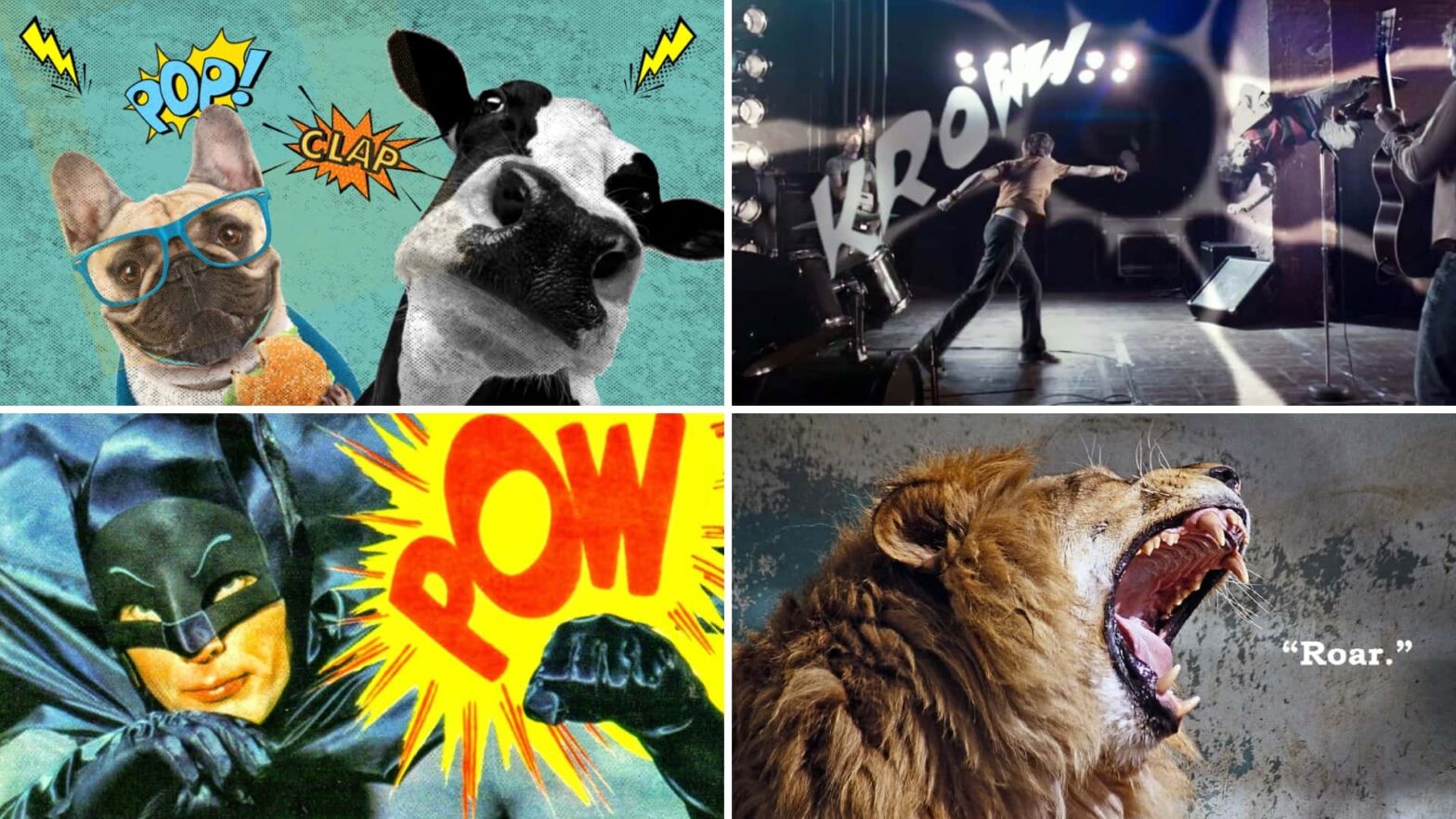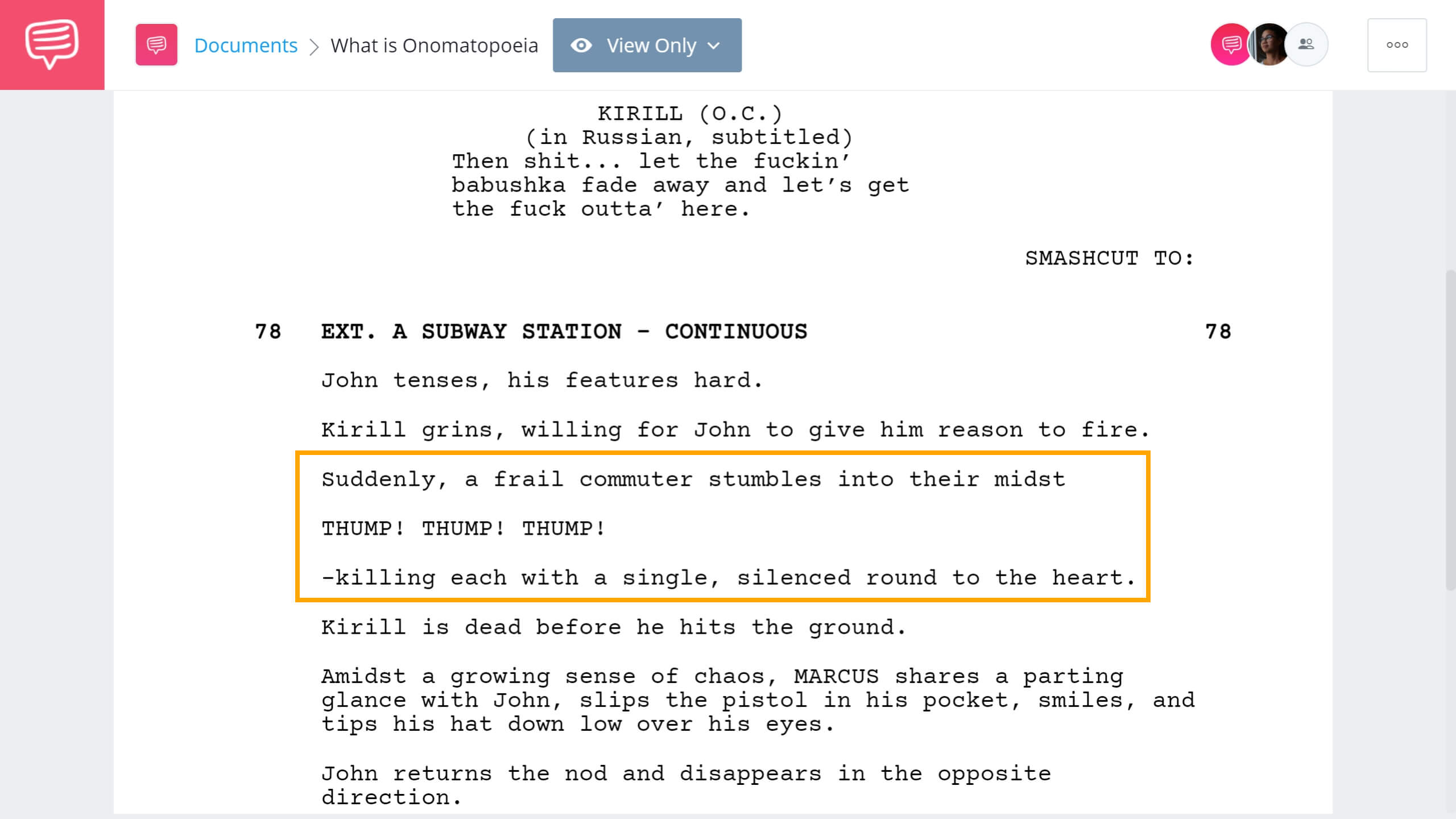Onomatopoeia can make a BANG or THUD in your mind when reading a sentence. And while that sentence is definitely not the best example of the effects of onomatopoeia, we’ll be taking a look at some actual good examples of the literary device in this article. What is onomatopoeia? Let’s dive into how writers use it in both literature and screenwriting to tell a more vivid and expressive story.
What is onomatopoeia
The definition of onomatopoeia
Onomatopoeia may be a difficult word to say and even more difficult to spell, but its definition is rather simple. Understanding the onomatopoeia definition will help you better understand how to use it to add depth to your writing. Let's define onomatopoeia and take a look at some onomatopoeia examples.
ONOMATOPOEIA DEFINITION
What is onomatopoeia?
Onomatopoeia is a literary device that uses the letter sounds of a word to imitate the natural sound emitted from an object or action. The word onomatopoeia can be traced back to the Ancient Greek word “onomatopoiia” which means the making of a word or name.
It can be found throughout language to assign certain words to the sound of an object or action. For example, “buzzing” may refer to the sound of a bee or “tick-tock” to the sound of a ticking clock.
How to Pronounce Onomatopoeia: on-oh-mott-oh-PEA-uh
Benefits of using onomatopoeia
- Adds rhythm to the action
- Creates vivid, immersive imagery
- Allows reader to understand the sound being expressed
What is onomatopoeia
Onomatopoeia examples
Even though we’ve covered the onomatopoeia definition, it may be difficult to understand without first taking a look at a few onomatopoeia examples.
- The tree fell in the forest and landed in a loud thump.
- He was just about in bed when he heard a ding-dong from the doorbell.
- The bee buzzed right above our heads.
- Knock-knock. All of their heads turned toward the front door.
- He ducked but was too late. Whack! The branch knocked him off his bike.
- We tip-toed through the living room and heard a woof from the backyard.
Onomatopoeia is a mechanism that allows the reader to understand the literal sound being communicated through the word. Now that we’ve covered a few everyday onomatopoeia examples, let’s take a look at how writers use them.
Onomatopoeia meaning
Onomatopoeia examples in literature
Onomatopoeia is commonly used in literature to engage a reader and bring them into a story. Before we dive into a literary example, take a look at this video to better understand the literary device.
Onomatopoeia examples • What is Onomatopoeia?
Onomatopoeia can capture a reader's attention and create depth to the world of a novel. For example, in Ernest Hemingway’s For Whom the Bell Tolls, Hemingway uses it to bring the reader into the world of the novel and experience of its characters. He writes:
“He saw nothing and heard nothing but he could feel his heart pounding and then he heard the clack on stone and the leaping, dropping clicks of a small rock falling.”
The “clack” of the stone and “clicks” of a small rock falling bring the story to life. The sentence itself could have made complete sense without the use of the literary device. But by using the literary device, Hemingway created a more vivid picture of what was occurring in the story. Onomatopoeia isn’t just used in literature. Screenwriters utilize it to illustrate sound effects in a screenplay.
Define Onomatopoeia
Onomatopoeia examples in screenplays
Screenwriters utilize various literary devices in a screenplay to tell a story designed for the big screen. This often includes finding ways to write more cinematic elements. When it comes to writing sound effects that are integral to a script’s plot, onomatopoeia is a screenwriter's best friend.
It is commonly used to portray the sound of objects and actions which is especially important when writing an epic fight scene. In this video tutorial, we breakdown techniques and tips to writing an epic fight scene like John Wick, like using onomatopoeia whenever a big moment in the fight occurs.
How to Write a Fight Scene Like John Wick • Subscribe on YouTube
Let’s take a look at the John Wick screenplay to see how screenwriter Derek Kolstad uses the literary device in an action sequence.
John Wick Example • Read Full Scene
The use of “THUMP” not only tells the reader what is happening, but makes the scene more cinematic — as it will be experienced on screen.
Just as onomatopoeias can be used in literature to engage a reader, it can be used in a screenplay to capture the reader’s attention by using cinematic elements like sound effects and sound design.
Although it is an important screenwriting tool, you don’t want to use it every other line in a screenplay. Using it sparingly for major moments during a fight sequence or scene will make it much more impactful.
UP NEXT
How storytellers use juxtaposition
Onomatopoeia is a great screenwriting tool to incorporate cinematic elements into a script. Another great literary device that does just that is juxtaposition. When used in a screenplay, juxtaposition can use sequence to tell a story and create meaning. Learn more about juxtaposition in the next article.

